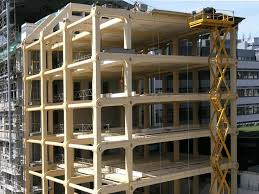Folding of xylan onto cellulose fibrils in plant cell walls
In December 2016, scientists published research into super-strength ‘glue’ that could enable the wider construction of low-energy timber high-rise buildings.
Published in the journal 'Nature Communications', the scientists at Cambridge and Warwick universities used nanoscale imaging to investigate the secret behind the strength of plant cell walls. In particular, the father-and-son team studied how key sugars in cells bind to form strong, indigestible materials.
The molecules of cellulose and xylan, which are 10,000 times narrower than the width of a human hair, are the two most common large molecules, or ‘polymers’. They are both found in the cell walls of materials such as wood and straw, and play an integral role in determining material strength and ease of break down. Compositionally, the two polymers are quite different – xylan is long and winding, with attachments of sugars and molecules; whereas cellulose is more thick and rod-like.
Professor Paul Depree, Department of Biochemistry, Cambridge University, said:
“We knew the answer must be elegant and simple … And in fact, it was. What we found was that cellulose induces xylan to untwist itself and straighten out, allowing it to attach itself to the cellulose molecule. It then acts as a kind of ‘glue’ that can protect cellulose or bind the molecules together, making very strong structures.”
Understanding how cellulose and xylan fit together could have a dramatic effect on industries as diverse as biofuels, paper production and construction, said Paul Dupree.
“One of the biggest barriers to ‘digesting’ plants – whether that’s for use as biofuels or as animal feed, for example – has been breaking down the tough cellular walls. Take paper production – enormous amounts of energy are required for this process. A better understanding of the relationship between cellulose and xylan could help us vastly reduce the amount of energy required for such processes.”
It is hoped that this latest discovery could help in the formation of stronger materials. There is a resurgence in the use of timber for high-rise developments, and Paul Depree is involved in Cambridge’s Centre for Natural Material Innovation which is researching modified wood as a building material for skyscrapers.
[edit] Find out more
[edit] Related articles on Designing Buildings Wiki
- 11 things you didn’t know about wood.
- Adhesives.
- Cross-laminated timber.
- ETFE.
- Glulam.
- Mastic sealant.
- Sustainable materials.
- Timber.
- Timber construction for London.
[edit] External references
- Folding of xylan onto cellulose fibrils in plant cell walls revealed by solid-state NMR, Thomas J. Simmons, Jenny C. Mortimer, Oigres D. Bernardinelli, Ann-Christin Pöppler, Steven P. Brown, Eduardo R. deAzevedo, Ray Dupree & Paul Dupree. Nature Communications, 21 December 2016.
Featured articles and news
RTPI leader to become new CIOB Chief Executive Officer
Dr Victoria Hills MRTPI, FICE to take over after Caroline Gumble’s departure.
Social and affordable housing, a long term plan for delivery
The “Delivering a Decade of Renewal for Social and Affordable Housing” strategy sets out future path.
A change to adoptive architecture
Effects of global weather warming on architectural detailing, material choice and human interaction.
The proposed publicly owned and backed subsidiary of Homes England, to facilitate new homes.
How big is the problem and what can we do to mitigate the effects?
Overheating guidance and tools for building designers
A number of cool guides to help with the heat.
The UK's Modern Industrial Strategy: A 10 year plan
Previous consultation criticism, current key elements and general support with some persisting reservations.
Building Safety Regulator reforms
New roles, new staff and a new fast track service pave the way for a single construction regulator.
Architectural Technologist CPDs and Communications
CIAT CPD… and how you can do it!
Cooling centres and cool spaces
Managing extreme heat in cities by directing the public to places for heat stress relief and water sources.
Winter gardens: A brief history and warm variations
Extending the season with glass in different forms and terms.
Restoring Great Yarmouth's Winter Gardens
Transforming one of the least sustainable constructions imaginable.
Construction Skills Mission Board launch sector drive
Newly formed government and industry collaboration set strategy for recruiting an additional 100,000 construction workers a year.
New Architects Code comes into effect in September 2025
ARB Architects Code of Conduct and Practice available with ongoing consultation regarding guidance.
Welsh Skills Body (Medr) launches ambitious plan
The new skills body brings together funding and regulation of tertiary education and research for the devolved nation.
Paul Gandy FCIOB announced as next CIOB President
Former Tilbury Douglas CEO takes helm.
UK Infrastructure: A 10 Year Strategy. In brief with reactions
With the National Infrastructure and Service Transformation Authority (NISTA).























